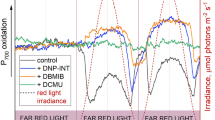Abstract
A series of replacement experiments of [14C]-triazines, [14C]-atrazine and [7-14C]-2-benzylamino-4-methyl-6-trifluoromethyl-1,3,5-triazine, bound to thylakoids isolated from wild-type and atrazine-resistant Chenopodium album (lambsquarters) were conducted. Replacement experiments of [14C]-triazines bound to wild-type Chenopodium thylakoids with non-labeled atrazine and 2-benzylamino-4-methyl-6-trifluoromethyl-1,3,5-triazine were carried out, to elucidate whether benzylamino-1,3,5-triazines use the same binding niche as atrazine. [14C]-Atrazine and [7-14C]-2-benzylamino-4-methyl-6-trifluoromethyl-1,3,5-triazine bound to wild-type thylakoids were replaced by non-labeled 2-benzylamino-4-methyl-6-trifluoromethyl-1,3,5-triazine and non-labeled atrazine, respectively. The above two replacements showed mutual competition. To clarify further whether benzylamino-1,3,5-triazines bind at the D1-protein to amino acid residue(s) different from atrazine or not, experiments to replace [7-14C]-2-benzylamino-4-methyl-6-trifluoromethyl-1,3,5-triazines bound to atrazine-resistant Chenopodium thylakoids by non-labeled atrazine, 2-(4-bromobenzylamino)-4-methyl-6-trifluoromethyl-1,3,5-triazine, DCMU and DNOC were carried out. Although the bound [7-14C]-2-benzylamino-4-methyl-6-trifluoromethyl-1,3,5-triazine was difficult to be replaced even with high concentrations of atrazine, [14C]-labeled 1,3,5-triazine was competitively replaced by non-labeled 2-(4-bromobenzylamino)-4-methyl-6-trifluoromethyl-1,3,5-triazine, DCMU or DNOC. Thus, 2-benzylamino-4-methyl-6-trifluoromethyl-1,3,5-triazine herbicides are considered to bind to the same niche at the D1 protein as atrazine, but use amino acid residue(s) different from those involved with atrazine binding.
Similar content being viewed by others
References
Arnon DI (1949) Copper enzymes in isolated chloroplast polyphenol-oxidase in Beta vulgaris. Plant Physiol 24: 1–15
Böger P (1982) Replacement of photosynthetic electron transport inhibitors by silicomolybdate. Physiol Plant 54: 221–224
Böger P (1985) The photosynthetic membrane as the target of herbicidal action, Plant Res Dev 21: 69–84
Jansen MAK, Hobé JH, Wesselius, JC and van Rensen JJS (1986) Comparison of photosynthetic activiy and growth performance in triazine-resistant and susceptible biotypes of Chenopodium album Physiol Vég 24: 475–484
Koizumi K, Kuboyama N, Tomono K, Tanaka A, Ohki A, Kohno H, Wakabayashi K and Böger P (1999) Novel 1,3,5-triazine derivatives with herbicidal activity. Pesticide Sci 55: 633–675
Kuboyama N, Koizumi K, Ohki S and Wakabayashi K (1998) Synthesis and herbicidal activity of 2-benzylamino-4-methyl-6-trifluoromethyl-1,3,5-triazine derivatives. J Pesticide Sci 23: 268–274
Kuboyama N, Koizumi K, Ohki A, Ohki S, Kohno H and Wakabayashi K (1999) Photosynthetic electron transport inhibitory activity of 2-arylalkylamino-4-methyl-6-trifluoromethyl-1,3,5-triazine derivatives. J Pesticide Sci 24: 138–142
Naber D, Johanningmeier U and van Rensen JJS (1990) A rapid method for partial mRNA and DNA sequence analysis of the Photosystem II psbA gene, Z Naturforsch 45c: 418–422
Oettmeier W, Masson K, Fedtke C, Konze J and Schmidt RR (1982) Effect of different Photosystem II inhibitors on chloroplasts isolated from species either susceptible or resistant towards-triazine herbicides. Pesticide Biochem Physiol 18: 357–367
Ohki A, Kuboyama N, Koizumi K, Tanaka A, Sato Y, Kohno H, Böger P and Wakabayashi K (1999) Mode of action of novel 2-(benzylamino)-4-methyl-6-(trifluoromethyl)-1,3,5-triazine herbicides: inhibition of photosynthetic electron transport and binding studies. J Agric Food Chem 47: 4398–4402
van Rensen JJS, van der Vet W and van Vliet WPA (1977) Inhibitionand uncoupling of electron transport in isolated chloroplasts by the herbicide 4,6-dinitro-o-cresol. Photochem Photobiol 25: 579–583
van Rensen JJS, Wong D and Govindjee (1978) Characterization of the inhibition of photosynthetic electron transport in pea chloroplasts by the herbicide 4,6-dinitro-o-cresol by comparative studies with 3-(3,4-dichlorophenyl)-1,1-dimethylurea. Z Naturforsch 33c: 413–420
Author information
Authors and Affiliations
Rights and permissions
About this article
Cite this article
Ikeda, Y., Ohki, S., Koizumi, K. et al. Binding site of novel 2-benzylamino-4-methyl-6-trifluoromethyl-1,3,5- triazine herbicides in the D1 protein of Photosystem II. Photosynthesis Research 77, 35–43 (2003). https://doi.org/10.1023/A:1024982804013
Issue Date:
DOI: https://doi.org/10.1023/A:1024982804013




